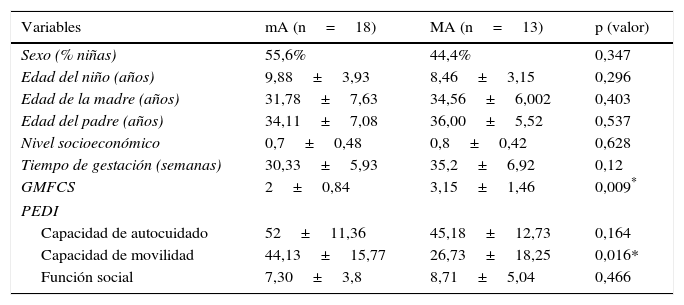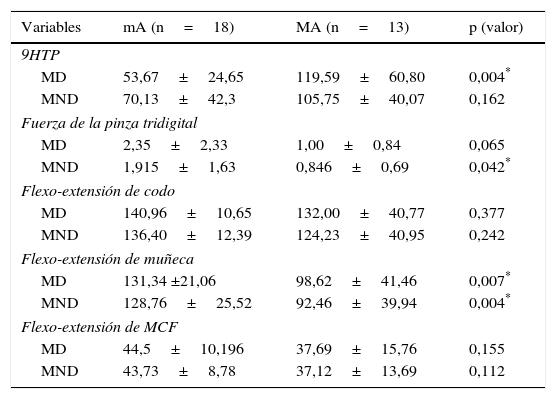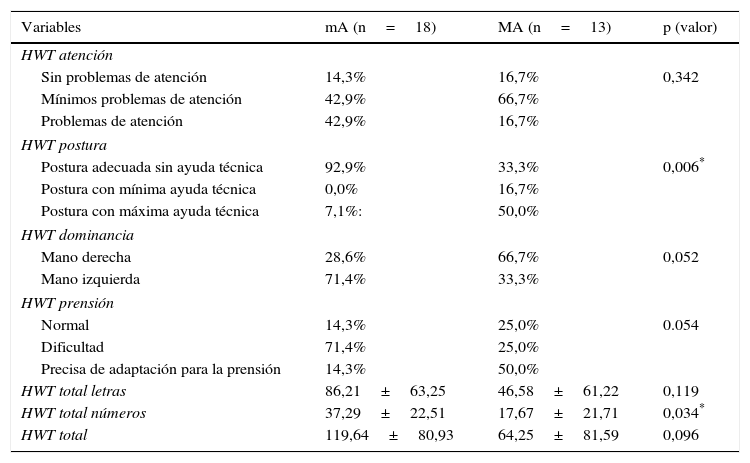Analizar las capacidades físicas de miembro superior y su relación con el nivel funcional en parálisis cerebral infantil (PCI).
Material y métodosEstudio descriptivo. Los participantes fueron niños diagnosticados de PCI escolarizados en colegios de educación especial. Las capacidades física y motora fueron evaluadas mediante la destreza manual, fuerza y rango de movimiento activo.
ResultadosLa muestra final estuvo compuesta por 31 niños con PCI escolarizados. Se dividieron en 2 grupos según el nivel funcional de los miembros superiores mediante la escala MACS. El grupo de menor afectación (n=18) englobaba los valores i y ii de la MACS, mientras que el grupo de mayor afectación recogió los valores iii, iv y v (n=13). Se encontraron diferencias significativas entre grupos en las variables GMFCS (p = 0,009), capacidad de movilidad evaluada con el PEDI (p = 0,016), en la destreza manual de la mano dominante evaluada con Nine Hole Peg Test (p=0,004), fuerza de la pinza de la mano no dominante (p=0,042), rango de movimiento activo de la articulación de la muñeca de ambas manos, postura al escribir y total de números escritos.
ConclusionesLos niños con PCI presentan una afectación de las capacidades motoras y funcionales. La afectación de la fuerza de la pinza digital, la destreza y la movilidad activa de la muñeca mostraron gran repercusión en la ejecución de las actividades de la vida diaria. Estrategias terapéuticas centradas en estas habilidades pueden resultar en mejores tasas de independencia funcional.
to analyse upper limb physical and motor skills of and their relation with functional independence in childhood cerebral palsy.
Material and methodsDescriptive survey. Participants were children diagnosed with childhood cerebral palsy (CCP) enrolled in special education schools. Physical and motor skills were evaluated through manual dexterity, strength and active range of motion.
ResultsThe final sample consisted of 31 children with CCP. They were divided in two groups according to the functional level of the upper limbs using MACS scale. The less affected group (n=18) encompassed the MACS's values i and ii, while the group most affected collected values iii, iv and v (n=13). Significant differences were found between groups in the variables GMFCS (P=.009), assessed mobility capacity using PEDI (P =.016) in the manual dexterity of the dominant hand assessed Nine Hole Peg Test (P=.004), clamp force of the non-dominant hand (P=.042), active range of motion of the wrist joint in both hands, typing position and total numbers written.
ConclusionsChildren with CCP show a motor and functional skills’ affectation. The strength of the digital clamp's affectation, the dexterity and the wrist's active mobility showed great impact on the implementation of the Activities of Daily Living. Therapeutic strategies focusing on these skills can result in best rates of functional independence.
Article
Si ya tiene sus datos de acceso, clique aquí.
Si olvidó su clave de acceso puede recuperarla clicando aquí y seleccionando la opción "He olvidado mi contraseña".










